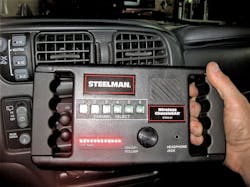THE SHOP:
Fink’s Garage in York, Pa., has been around since the late 1920s and has been in its current location since the 1930s. The seven-bay, 6,000-square-foot shop sees 200 cars per month. Damian Deller is a third-generation owner of the shop.
THE REVIEWER:
For Deller, the customer always comes first, which means he wants to be as close to 100 percent as possible in the accuracy of his repair recommendations. Deller was flipping through a magazine one day and found the Steelman Wireless ChassisEAR Diagnostic Device Kit. The kit is different than a standard stethoscope used by many shops can be used while the vehicle is in use. Taking all of this into consideration, Deller thought it would be a good tool to help with suspension noises and decided to make the investment.
HOW IT WORKS:
The kit comes with a wireless channel receiver and has four sensors that resemble mini walkie-talkies that can be connected to different parts of the vehicle with alligator clamps (also included). The sensors should be placed on the part of the vehicle that the user suspects is causing the noise. The sensors, which are electrical and sent out via radio frequencies, are numbered to correlate with a radio channel on the receiver. Once the sensors are connected to the troublesome parts of the car, the user can take the wireless receiver in the car and begin driving. The user can go back and forth between the different channels to listen to the sensors and identify where the noise is coming from while driving.
THE REVIEW:
“I’m starting to lose my hearing,” Deller says. “This helps me hone in on the area of the car that the noise is coming from.”
Deller uses the Wireless ChassisEAR a few times each month on vehicles that have hard to identify noises. He says that it helps him mainly with hub bearings, specifically identifying which side is causing the noise.
Deller has used Steelman products before and he says they hold up remarkably well, the ChassisEAR being no exception. A feature that he particularly likes is the volume dial, which he says has helped over the years as his hearing gets worse. Deller does have one issue: the amount of batteries it requires to run. The wireless transmitter requires six batteries and, altogether, the four sensors require 16 AA batteries.
THE ROI:
Deller says that the ChassisEAR pays for itself within a few uses. Using the kit has saved Deller valuable time and has helped him sell more jobs with confidence.
“If I don’t feel secure in my diagnosis, then I don’t want to do anything,” Deller says. “I want to wait until I’m sure. I would rather be sure than spend my customer’s money. Using this has helped me be more definitive in my diagnosis and sell more jobs.”



